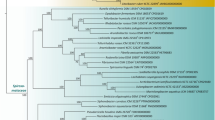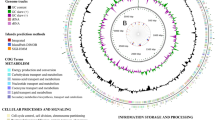Abstract
Strain IMCC1322 was isolated from a surface water sample from the East Sea of Korea. Based on 16S rRNA analysis, IMCC1322 was found to belong to the OCS28 sub-clade of SAR116. The cells appeared as short vibrioids in logarithmic-phase culture, and elongated spirals during incubation with mitomycin or in aged culture. Growth characteristics of strain IMCC1322 were further evaluated based on genomic information; proteorhodopsin (PR), carbon monoxide dehydrogenase, and dimethylsulfoniopropionate (DMSP)-utilizing enzymes. IMCC1322 PR was characterized as a functional retinylidene protein that acts as a light-driven proton pump in the cytoplasmic membrane. However, the PR-dependent phototrophic potential of strain IMCC1322 was only observed under CO-inhibited and nutrient-limited culture conditions. A DMSP-enhanced growth response was observed in addition to cultures grown on C1 compounds like methanol, formate, and methane sulfonate. Strain IMCC1322 cultivation analysis revealed biogeochemical processes characteristic of the SAR116 group, a dominant member of the microbial community in euphotic regions of the ocean. The polyphasic taxonomy of strain IMCC1322 is given as Candidatus Puniceispirillum marinum, and was confirmed by chemotaxonomic tests, in addition to 16S rRNA phylogeny and cultivation analyses.
Similar content being viewed by others
References
Balashov, S.P. and Lanyi, J.K. 2007. Xanthorhodopsin: Proton pump with a carotenoid antenna. Cell. Mol. Life Sci. 64, 2323–2328.
Bano, N. and Hollibaugh, J.T. 2002. Phylogenetic composition of bacterioplankton assemblages from the Arctic Ocean. Appl. Environ. Microbiol. 68, 505–518.
Beja, O., Spudich, E.N., Spudich, J.L., Leclerc, M., and DeLong, E.F. 2001. Proteorhodopsin phototrophy in the ocean. Nature 411, 786–789.
Britschgi, T.B. and Giovannoni, S.J. 1991. Phylogenetic analysis of a natural marine bacterioplankton population by rRNA gene cloning and sequencing. Appl. Environ. Microbiol. 57, 1707–1713.
Chin, B.Y. and Otterbein, L.E. 2009. Carbon monoxide is a poison… to microbes! CO as a bactericidal molecule. Curr. Opin. Pharmacol. 9, 490–500.
Cho, J.C. and Giovannoni, S.J. 2004. Cultivation and growth characteristics of a diverse group of oligotrophic marine Gamma-proteobacteria. Appl. Environ. Microbiol. 70, 432–440.
Cho, J.C. and Giovannoni, S.J. 2006. Pelagibaca bermudensis gen. nov., sp. nov., a novel marine bacterium within the Roseobacter clade in the order Rhodobacterales. Int. J. Syst. Evol. Microbiol. 56, 855–859.
Choo, Y.J., Lee, K., Song, J., and Cho, J.C. 2007. Puniceicoccus vermicola gen. nov., sp. nov., a novel marine bacterium, and description of Puniceicoccaceae fam. nov., Puniceicoccales ord. nov., Opitutaceae fam. nov., Opitutales ord. nov. and Opitutae classis nov. in the phylum ‘Verrucomicrobia’. Int. J. Syst. Evol. Microbiol. 57, 532–537.
Connon, S.A. and Giovannoni, S.J. 2002. High-throughput methods for culturing microorganisms in very-low-nutrient media yield diverse new marine isolates. Appl. Environ. Microbiol. 68, 3878–3885.
Douglas, E. 1967. Carbon monoxide solubilities in sea water. J. Phys. Chem. 71, 1931–1933.
Dupont, C.L., Rusch, D.B., Yooseph, S., Lombardo, M.J., Richter, R.A., Valas, R., Novotny, M., Yee-Greenbaum, J., Selengut, J.D., Haft, D.H., et al. 2012. Genomic insights to SAR86, an abundant and uncultivated marine bacterial lineage. ISME J. 6, 1186- 1199.
Finn, R.D., Tate, J., Mistry, J., Coggill, P.C., Sammut, S.J., Hotz, H.R., Ceric, G., Forslund, K., Eddy, S.R., Sonnhammer, E.L., et al. 2008. The Pfam protein families database. Nucleic Acids Res. 36, D281- D288.
Giovannoni, S.J., Bibbs, L., Cho, J.C., Stapels, M.D., Desiderio, R., Vergin, K.L., Rappe, M.S., Laney, S., Wilhelm, L.J., Tripp, H.J., et al. 2005. Proteorhodopsin in the ubiquitous marine bacterium SAR11. Nature 438, 82–85.
Giovannoni, S.J., Britschgi, T.B., Moyer, C.L., and Field, K.G. 1990. Genetic diversity in Sargasso Sea bacterioplankton. Nature 345, 60–63.
Giovannoni, S.J. and Rappé, M.S. 2000. Evolution, diversity, and molecular ecology of marine prokaryotes, pp. 47–84. In Kirchman, D.L.E. (ed.), Microbial ecology of the oceans. Wiley-Liss New York, USA.
Gómez-Consarnau, L., Akram, N., Lindell, K., Pedersen, A., Neutze, R., Milton, D.L., González, J.M., and Pinhassi, J. 2010. Proteor-hodopsin phototrophy promotes survival of marine bacteria during starvation. PLoS Biol. 8, e1000358.
Gómez-Consarnau, L., González, J.M., Coll-Llado, M., Gourdon, P., Pascher, T., Neutze, R., Pedros-Alio, C., and Pinhassi, J. 2007. Light stimulates growth of proteorhodopsin-containing marine Flavobacteria. Nature 445, 210–213.
González, J.M., Fernández-Gómez, B., Fernàndez-Guerra, A., Gomez-Consarnau, L., Sánchez, O., Coll-Lladó, M., Del Campo, J., Escudero, L., Rodríguez-Martínez, R., Alonso-Saez, L., et al. 2008. Genome analysis of the proteorhodopsin-containing marine bacterium Polaribacter sp. MED152 (Flavobacteria). Proc. Natl. Acad. Sci. USA 105, 8724–8729.
Grote, J., Bayindirli, C., Bergauer, K., Carpintero de Moraes, P., Chen, H., D’Ambrosio, L., Edwards, B., Fernandez-Gómez, B., Hamisi, M., Logares, R., et al. 2011. Draft genome sequence of strain HIMB100, a cultured representative of the SAR116 clade of marine Alphaproteobacteria. Stand. Genomic Sci. 5, 269–278.
Johnson, E.T., Baron, D.B., Naranjo, B., Bond, D.R., Schmidt-Dan-nert, C., and Gralnick, J.A. 2010. Enhancement of survival and electricity production in an engineered bacterium by light-driven proton pumping. Appl. Environ. Microbiol. 76, 4123–4129.
Jorgensen, J.H., Turnidge, J.D., and Washington, J.A. 1999. Antibacterial susceptibility tests: dilution and disk diffusion method, pp. 1526–1543. In Murray, P.R., Baron, E.J., Pfaller, M.A., Tenover, F.C., and Yolken, R.H. (eds.), Manual of clinical microbiology. American Society for Microbiology, Washington, DC, USA.
Kang, I., Oh, H.M., Kang, D., and Cho, J.C. 2013. Genome of a SAR-116 bacteriophage shows the prevalence of this phage type in the oceans. Proc. Natl. Acad. Sci. USA 110, 12343–12348.
Kim, S.Y., Waschuk, S.A., Brown, L.S., and Jung, K.H. 2008. Screening and characterization of proteorhodopsin color-tuning mutations in Escherichia coli with endogenous retinal synthesis. Bio-chim. Biophys. Acta 1777, 504–513.
King, G.M. and Weber, C.F. 2007. Distribution, diversity and ecology of aerobic CO-oxidizing bacteria. Nat. Rev. Microbiol. 5, 107–118.
Ludwig, W., Strunk, O., Westram, R., Richter, L., Meier, H., Yadhu-kumar, Buchner, A., Lai, T., Steppi, S., Jobb, G., et al. 2004. ARB: a software environment for sequence data. Nucleic Acids Res. 32, 1363–1371.
Macleod, R.A. 1965. The question of the existence of specific marine bacteria. Bacteriol. Rev. 29, 9–24.
Minnikin, D.E., O’Donnell, A.G., Goodfellow, M., Alderson, G., Athalye, M., Schaal, A., and Parlett, J.H. 1984. An integrated procedure for the extraction of bacterial isoprenoid quinones and polar lipids. J. Microbiol. Methods 2, 233–241.
Moran, M.A., Buchan, A., González, J.M., Heidelberg, J.F., Whitman, W.B., Kiene, R.P., Henriksen, J.R., King, G.M., Belas, R., Fuqua, C., et al. 2004. Genome sequence of Silicibacter pomeroyi reveals adaptations to the marine environment. Nature 432, 910–913.
Moran, M.A. and Miller, W.L. 2007. Resourceful heterotrophs make the most of light in the coastal ocean. Nat. Rev. Microbiol. 5, 792–800.
Mullins, T.D., Britschgi, T.B., Krest, R.L., and Giovannoni, S.J. 1995. Genetic comparisons reveal the same unknown bacterial lineages in Atlantic and Pacific bacterioplankton communities. Limnol. Oceanogr. 40, 148–158.
Noble, R.T. and Fuhrman, J.A. 1998. Use of SYBR Green I for rapid epifluorescence counts of marine viruses and bacteria. Aquat. Microb. Ecol. 14, 113–118.
Oh, H.M., Kang, I., Lee, K., Jang, Y., Lim, S.I., and Cho, J.C. 2011. Complete genome sequence of strain IMCC9063, belonging to SAR11 subgroup 3, isolated from the Arctic Ocean. J. Bacteriol. 193, 3379–3380.
Oh, H.M., Kwon, K.K., Kang, I., Kang, S.G., Lee, J.H., Kim, S.J., and Cho, J.C. 2010. Complete genome sequence of “Candidatus Puni-ceispirillum marinum” IMCC1322, a representative of the SAR116 clade in the Alphaproteobacteria. J. Bacteriol. 192, 3240–3241.
Ohta, K. 1997. Diurnal variations of carbon monoxide concentration in the equatorial Pacific upwelling region. Oceanogr. Lit. Rev. 44, 1258.
Pruesse, E., Quast, C., Knittel, K., Fuchs, B.M., Ludwig, W., Peplies, J., and Glockner, F.O. 2007. SILVA: a comprehensive online resource for quality checked and aligned ribosomal RNA sequence data compatible with ARB. Nucleic Acids Res. 35, 7188–7196.
Purcell, E.M. 1977. Life at low reynolds number. Am. J. Phys. 45, 3–11.
Rappé, M.S., Kemp, P.F., and Giovannoni, S.J. 1997. Phylogenetic diversity of marine coastal picoplankton 16S rRNA genes cloned from the continental shelf off Cape Hatteras, North Carolina. Limnol. Oceanogr. 42, 811–826.
Reasoner, D.J. and Geldreich, E.E. 1985. A new medium for the enumeration and subculture of bacteria from potable water. Appl. Environ. Microbiol. 49, 1–7.
Reisch, C.R., Moran, M.A., and Whitman, W.B. 2011. Bacterial cata-bolism of dimethylsulfoniopropionate (DMSP). Front. Micro-biol. 2, 172.
Sabehi, G., Loy, A., Jung, K.H., Partha, R., Spudich, J.L., Isaacson, T., Hirschberg, J., Wagner, M., and Beja, O. 2005. New insights into metabolic properties of marine bacteria encoding proteor-hodopsins. PLoS Biol. 3, e273.
Schwalbach, M.S., Brown, M., and Fuhrman, J.A. 2005. Impact of light on marine bacterioplankton community structure. Aquat. Microb. Ecol. 39, 235–245.
Spring, S., Lunsdorf, H., Fuchs, B.M., and Tindall, B.J. 2009. The photosynthetic apparatus and its regulation in the aerobic gam-maproteobacterium Congregibacter litoralis gen. nov., sp. nov. PLoS One 4, e4866.
Steindler, L., Schwalbach, M.S., Smith, D.P., Chan, F., and Giovan-noni, S.J. 2011. Energy starved Candidatus Pelagibacter ubique substitutes light-mediated ATP production for endogenous carbon respiration. PLoS One 6, e19725.
Stingl, U., Desiderio, R.A., Cho, J.C., Vergin, K.L., and Giovannoni, S.J. 2007a. The SAR92 clade: an abundant coastal clade of cul-turable marine bacteria possessing proteorhodopsin. Appl. Environ. Microbiol. 73, 2290–2296.
Stingl, U., Tripp, H.J., and Giovannoni, S.J. 2007b. Improvements of high-throughput culturing yielded novel SAR11 strains and other abundant marine bacteria from the Oregon coast and the Bermuda Atlantic time series study site. ISME J. 1, 361–371.
Stubbins, A., Uher, G., Law, C.S., Mopper, K., Robinson, C., and Up-still-Goddard, R.C. 2006. Open-ocean carbon monoxide photoproduction. Deep Sea Res. Part II Top. Stud. Oceanogr. 53, 1695–1705.
Swofford, D.L. 2002. PAUP: phylogenetic analysis using parsimony, version 4.0b10. Sinauer Associates, Sunderland, MA, USA.
Treusch, A.H., Vergin, K.L., Finlay, L.A., Donatz, M.G., Burton, R.M., Carlson, C.A., and Giovannoni, S.J. 2009. Seasonality and vertical structure of microbial communities in an ocean gyre. ISME J. 3, 1148–1163.
Vergin, K.L., Rappe, M.S., and Giovannoni, S.J. 2001. Streamlined method to analyze 16S rRNA gene clone libraries. BioTechniques 30, 938–944.
Walter, J.M., Greenfield, D., Bustamante, C., and Liphardt, J. 2007. Light-powering Escherichia coli with proteorhodopsin. Proc. Natl. Acad. Sci. USA 104, 2408–2412.
Wang, W.W., Sineshchekov, O.A., Spudich, E.N., and Spudich, J.L. 2003. Spectroscopic and photochemical characterization of a deep ocean proteorhodopsin. J. Biol. Chem. 278, 33985–33991.
Worden, Z.A. and Not, F. 2008. Ecology and diversity of picoeu-karyotes, pp. 159–205. In Kirchman, D.L.E. (ed.), Microbial ecology of the oceans, 2nd ed. John Wiley & Sons, Inc., New York, USA.
Yoch, D.C. 2002. Dimethylsulfoniopropionate: Its sources, role in the marine food web, and biological degradation to dimethyl-sulfide. Appl. Environ. Microbiol. 68, 5804–5815.
Zafiriou, O.C., Andrews, S.S., and Wang, W. 2003. Concordant estimates of oceanic carbon monoxide source and sink processes in the Pacific yield a balanced global “blue‐water” CO budget. Global Biogeochem. Cycles 17, 1015.
Acknowledgements
This research was supported by the Marine Biotechnology Program of the Korea Institute of Marine Science and Technology Promotion (KIMST) funded by the Ministry of Oceans and Fisheries (MOF) [No. 20180430]; and by the Korea National Research Fund [NRF-2017R1D1A1B03034706].
Author information
Authors and Affiliations
Corresponding authors
Additional information
Supplemental material for this article may be found at http://www.springerlink.com/content/120956.
Electronic supplementary material
Rights and permissions
About this article
Cite this article
Lee, J., Kwon, K.K., Lim, SI. et al. Isolation, cultivation, and genome analysis of proteorhodopsin-containing SAR116-clade strain Candidatus Puniceispirillum marinum IMCC1322. J Microbiol. 57, 676–687 (2019). https://doi.org/10.1007/s12275-019-9001-2
Received:
Revised:
Accepted:
Published:
Issue Date:
DOI: https://doi.org/10.1007/s12275-019-9001-2




